Six North Faces of the Alps: Cima Grande
The North Face of Cima Grande
The Brandler/Hasse
Time taken: 1 day
Climbing team: Stuart McAleese, Neil Johnson
Photo Credit: IFMGA Mountain Guide Tim Neill
.
Trip Report
By Stuart McAleese
It was Summer 2002 and I was camping in Chamonix. It was mid-summer and everyone was making plans for the mountains. We were all thinking of big routes but the weather and conditions at the time didn’t really match up. I remember chatting with my friend Neil Johnson who was also out climbing. It was raining, and we were thinking of potential climbing plans and having a coffee. As can happen in the Alps, there was no real end in sight due to the poor weather. I needed a plan but was reluctant to bail from the Alps completely, so when Neil mentioned the Dolomites, I was intrigued.
I had been to the Dolomites in the past and it was my first trip to the Alps with a University friend. I was kind of surprised by the thought of climbing in the Dolomites as it was so far away, so it took me a little while to process. However looking at the weather forecast once more we both decided it was going to be worth it.
The Dolomites were absolutely not on my radar so I asked Neil what routes had he been thinking about? I knew of a few places from climbing there before and felt quite cautious as mentally I was in mountaineering mode and the Dolomites is full on rock climbing, especially some of the routes he had mentioned. I was needing a little more inspiration, then Neil said it! “What about the Brandler/Hasse on the North Face of the Cima Grande?” At the time, for me, challenges didn’t come much bigger and we both knew very little about the climb, which for me made it feel even more special and exciting!
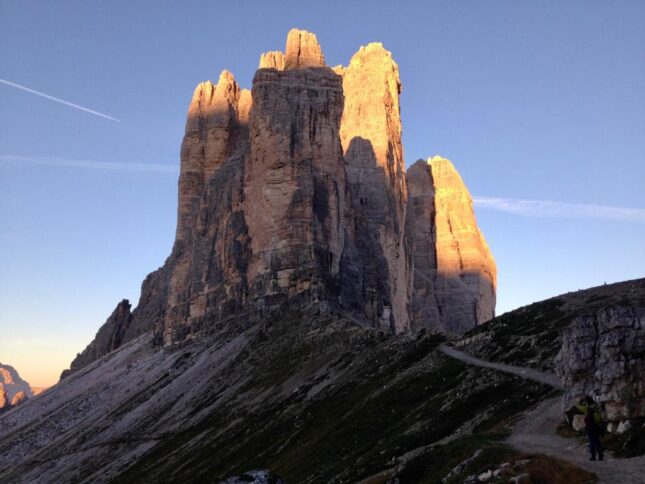
Photo IFMGA Mountain Guide Tim Neill
.
It turned out that not many of our friends knew much either and of the few friends I knew who had climbed the route, all of them were amazing big wall climbers… My next big question was how hard is the route and what grade is it given? It was a rock grade of 7a+ with many pitches at 7a/6c (British E4/5). Again, I needed some time to process this and sat drinking coffee in the rain as I tried my best to visualise how hard that would be and if it was possible.
We looked at the guidebook description and topo and planned how the route might be climbed, thinking over the logistics before committing. Neil is a superb rock climber and strong Alpine mountaineer, who is awesome at big adventurous climbs, and at the time we both had ambitions to become Mountain Guides. Neil’s experience and ability inspired me, and we made for a good team on this trip, and with our combined enthusiasm and optimism for the Cima Grande, we decided to make plans and leave the next day for Cortina.
Leaving a rainy Chamonix the road trip to the Dolomites was on! We were driving across in Neil’s van which he had converted into a camper, this was new to me and I was quite excited about not having to put my little tent up again! It was nice to see the weather slowly improve as we drove further East through Switzerland and towards Italy. We had a laugh swapping climbing stories and stopping for the odd coffee break, whatever happened regarding the outcome of the climbing, we both knew we would have a good time, and were both looking forward to Italian pizza and red wine in Cortina that evening. Our plan for the next day was to check out the approach and maybe climb the first few pitches of the route, hoping to give us a little insight to the climb.
After a long day driving, we arrived late in Cortina, feeling quite tired and hungry, we were both relieved not to be climbing the whole route the next day and looked forward to some nice food that evening.
It all felt quite different sat in a nice little Italian restaurant after a relatively quick transition from our Chamonix campsite and it was now starting to feel like a proper little adventure. Looking outside into the quiet street the weather was amazing with a clear evening, the view looked very different and we both were feeling happy with our decision and plan for climbing here in the Dolomites. Cortina is a famous mountain town in Northern Italy, known for the amazing climbing, mountaineering, and trekking in summer, but also a ski resort in winter and hosted the winter games in 1956 and ski world cup races. It is also known as one of the most fashionable ski resorts in Italy, so as climbers we tried our best to blend in and it was fun watching the odd Ferrai drive past!
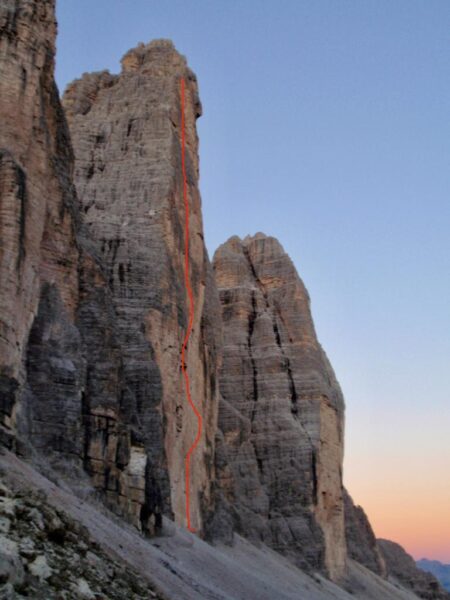
The route. Photo IFMGA Mountain Guide Tim Neill
Enjoying the Italian atmosphere, we had a little coffee after dinner and chatted through plans. We slept somewhere near Cortina that evening and the next day drove up early to the mountains and the Tre Cime. Our plan was to park up at the top car park near the Tre Cime and base ourselves there for the next couple of days. The weather was amazing, and we sorted out the kit that we needed for the reconnaissance climb by the van. I was loving the van-based adventures, a real luxury and a first for me and it was great way to move around with lots of climbing gear too.
We packed all our climbing gear and were thinking to leave some at the base of the route to make our approach easier the next day. We packed a complete climbing rack and 2 x 60m half ropes. We had heard that there are a lot of fixed kit/bolts, so we took a few extra quickdraws. The next challenge was clothing and what to take as spares? We had to climb as light as possible and went for a minimum weight and bulk, so the lead climber did not have to carry a rucksack, just the second! This would then be swapped over at each block changeover. It’s quite important not to underestimate the challenge faced by the second climbing with a heavy rucksack, therefore we aimed to keep this single rucksack as light a possible. On tough routes it is possible to haul a bag, freeing up any weight having to be carried by a person. This is great however can be slow and sometimes complicated.
As for water and spare clothing, we aimed to carry a litre each and a thin down jacket each. The weather forecast was good, but we had heard about how cold it can get on the Tre Cime North Faces. With bags all packed we set off from the van on our recce, hoping to climb the initial pitches of the route and maybe even fix our ropes too.
The Tre Cime are close to the car park at about an hours walk and you approach the mountain on a good footpath from the South. Unfortunately you are unable to see the North Face from this direction until you arrive at the Rifugio Lavaredo, a mountain hut near the base of Tre Cime. The path was good and soon we were at the mountain hut and from here you look across and can see the impressive North Faces of the Tre Cime, at which point both of us felt the size and scale of the mission we had chosen. The Cima Grande is the central pillar and the tallest, with close to a 600m vertical North Face and in parts its rock wall overhangs.
With a slight nervous smile, I looked at Neil and we both agreed to ‘have a look’.
As we walked up and across the slope towards the North Face, we entered its shadow and instantly the temperature dropped. We felt the cold air and slight breeze but carried on walking, every now and again looking up, only to see a huge North Face rock wall looming above. The route we were going to try was around 19 pitches and up to 7a+, which is around UK E4/E5, and taking one step at a time we tried not to think about the size of the wall. Today we were only going to climb a few pitches to ‘break the ice’ and find out more about the climb.
Hoping the rock was not going to be too cold we arrived at the base of the wall and took the guidebook out to have a look for where the route started exactly.
The huge North Face was directly above us and we both looked up in amazement at how impressive it looked. The limestone made it look a pale yellow colour in parts and you could just make out the hand holds and foot ledges. Looking closely we could see the line of our route and we quickly noticed the overhanging terrain in the mid-section our climb goes through. This route was going to be a massive challenge for both of us. Excited by this and a little apprehensive, we knew it was going to draw upon all our climbing experience as a team to summit successfully. However, I tried to remind myself – one stage at a time, and to try to enjoy our ‘ice breaker’ and reconnaissance of the first few pitches.
Historically the first ascent was in 1958 by Lothar Brandler and Dieter Hasse, and established as an aid climb, a technique whereby the climbers would place pitons and other climbing equipment into the rock and cracks and then continue to stand/pull on this to climb higher. This technique is called aid climbing and is normally used when the rock climb is too difficult to climb normally using gear as protection only. It was first free climbed in 1987 by Kurt Albert and then a Free Solo ascent by Alex Huber in 2002.
The climb was known as one of the original ‘superdirettisimas’ on the North Faces of the Alps, and an adventurous aid climb through some big overhanging terrain. All this important history is one aspect that makes these routes so special and it always feels such a privilege to climb and experience the routes first hand. We were hoping to free climb the route but we also felt that was quite optimistic and in reality it would likely be a combination of techniques that would make our ascent successful.
The original North Face route original North Face route was climbed by Emilio Comici, Giuseppe Dimai and Angelo Dimai in August 1933. This was the first ascent of the North Face and for a long time was believed to be unclimbable and was an important move in world alpine climbing. This route is regarded as the classic and one of the six north face routes. I went back a few years later and climbed this route with Tim Neill and Phil Sanderson. We climbed the route through some stormy weather, the day started fine, and I remember it being a little cold. Mid-way up the route snow showers started to blow over and near the top of the route the snow became a lot more continuous. We managed to continue for a little longer just in reach of the traverse ledge and our descent, however the snow was a lot heavier by then and the traverse ledge was covered in snow and ice. Unable to continue we had no option but to abseil the entire route. This was not easy and quite intimidating abseiling a 500m rock wall sometimes overhanging in a snowstorm. I remember on reaching the base of the route and having to dig our spare kit out of the snow and battle our way back around in what was like a Scottish blizzard. Happy to be down and off the mountain that day, all of us needed a strong coffee after that one!
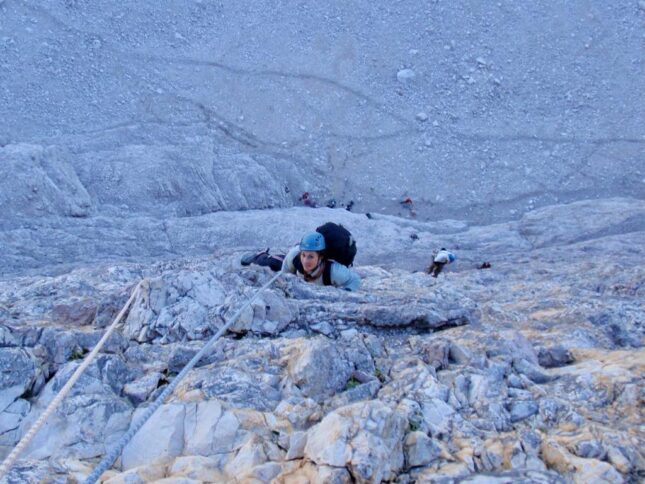
Lou Neill climbing on the Comici route. Photo by IFMGA Mountain Guide Tim Neill
The weather was good, and we were starting to slowly got used to the shadow of the North Face and the colder air. At first touch the rock felt icy cold and the thought of putting rock boots on was quite awful, so I aimed to put that moment off for as long as possible. One little trick in times like these is to put your rock boots down your jacket while you’re racking up, and just before putting them on a little blow of warm air into them takes the edge off the cold leather.
One step at a time, I led off and was initially confused and couldn’t tell if the rock was icy or just polished. It was an easy first few pitches but soon it felt wild climbing on this massive North Face and whilst we were climbing, our thoughts were on how difficult we would find this in the dark the next morning. We needed all of the next day to climb the route so our plan to maximise time was to climb these first few pitches early in the morning when it would likely be still dark.
Now a few pitches up we felt we had ‘broken the ice’ and got a good feeling about the climbing and pleased with our progress we felt reassured.
Hanging from a belay a few pitches up, we looked at the route above. We both knew a lot of harder climbing lay ahead and that it was going to be a big day for us both. We knew very little about the route and only knew of a few friends who had climbed it before. We were quite young at the time and less experienced, so we felt we were no match to these famous climbing friends who had climbed the route before. It was starting feel like a proper adventure with lots of unknowns. We had heard others used aid climbing techniques so we gave this some thought too, however hanging on this belay looking up I think we felt we could try our best before committing to a full aid ascent. Feeling excited, we both agreed we had seen enough, and it was now time to abseil back down and make our way back to the van.
Walking back out of the shadow of the North Face and into the warm summer sun, we both chatted through what we had seen on the route and our thoughts about tomorrow. We agreed on the same plan and then soon our thoughts were on dinner and a little red wine by the van in the sun.
We had a quiet evening and a big dinner, fuelling up for the big climb the next day. All the tourists had gone for the day and all was quiet, relaxing and sorting the last bits of gear before some rest and sleep. We had left most of the gear at the base of the route, so all we needed was some extra food and water. It’s always difficult to judge how much water to carry on climbs like this, as water is heavy, so in the end we opted for the standard litre each with some extra to have when we arrive at the base of the route. It’s always hard to relax and not think of the climb the night before, when you are slightly nervous with anticipation and the unknown fills your mind, but the home comforts of the van helped. Alarms set and breakfast and stove ready for an early start, we tried to sleep.
Morning time and it was still dark, around 03:00am and it’s also never easy to get up. However, focused on the job we managed a tiny breakfast (it’s hard to eat at that time of day) and we got ready. Around 2 hours later after easy walking we were at the base of our fixed ropes and the start of our climb.
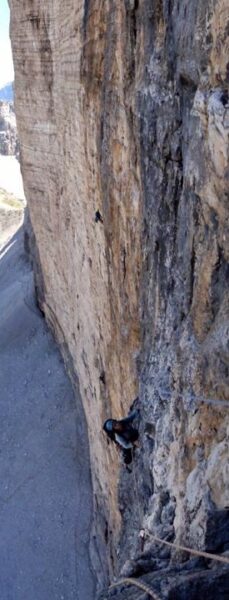
Climbing on the route. Photo from IFMGA Mountain Guide Tim Neill
Feeling quite awake now but still in the dark we got all our climbing gear on and started climbing. We were both pleasantly surprised to find the climbing and route-finding easier than expected. It helped loads having climbed these first few pitches the day before. Head torches limiting the distance of our vision, we felt very small seeing the rock wall above us in the dark.
It slowly started to get light and we arrived in good time at our previous high point from the day before. We paused here for a moment for some food and water, also a quick look at the topo to confirm our route and next pitch.
I set off on what was to be one of the early hard pitches of the route and the climbing instantly felt quite intense. I could see where I was going and could also make out the rest of the route from here too. Aiming to climb the route as clean as possible we were trying our best not to pull on bolts or old pitons. However, this was far too tempting at times, especially when the climbing was so hard and there was so much more above us to overcome.
We both laughed as I struggled on a section trying not pull on a bolt – aiming to climb the route as clean as possible didn’t last long! I quickly pulled on the bolt and we both laughed again, this was quite normal but maybe not what we were aiming for. We climbed a few more pitches and soon our ropes at the belays were swinging in space, as the wall was starting to overhang below us.
Still on route we traversed out left and paused at another belay. Looking up to harder climbing and the overhanging wall beneath us we both nervously agreed an abseil from here would be tricky. The route above us from here made a rising rightwards line through a number of little overhangs, and the next 4 pitches were graded around E4/5 (7a/7a+).
I looked up and rightward and all the climbing looked wild and I remember feeling quite gripped and a little nervous of these next hard pitches. This was going to be pitch number 10 so I was feeling a little tired but had little option but to try and keep going. We had a little team chat and Neil was feeling strong, this reassured me and looking closely we could see a way. I knew it was going to require everything but we both really wanted to try our best. I didn’t feel ready for the route and again wished I’d done more climbing/training – however faced with the challenge as a team we stayed positive.
Drawing upon all of my, what felt like, limited climbing experience, I managed to reach the next belay, feeling worked but happy in the belief that we could do it. The next few pitches were similar, and the rock was good and still had chalk on the hand holds from previous ascents. Feeling high on the wall now we both paused at a belay to look around and enjoy the adventure.
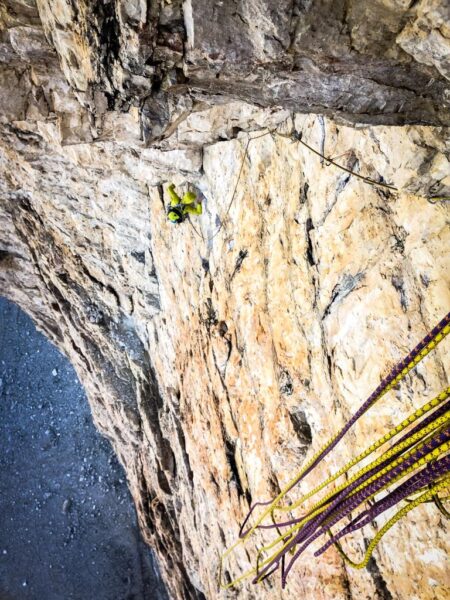
Photo from IFMGA Mountain Guide Tim Neill
Each of the consecutive hard pitches felt totally desperate, and I’m not sure which was harder, leading or seconding with a heavy rucksack. Learning how to climb these hard overhanging pitches and keep pace on such a big wall was brand new to me and felt like a proper workout mentally and physically.
We still had time, but it was already starting to feel like a long day, and totally pumped we both clipped in to the belay above the hard climbing and smiled. We still had around 6 pitches of climbing to go and the grade had eased off but we knew there were a couple of big chimneys to climb and there was a risk they would likely feel quite horrendous at this stage of the climb.
My hands and arms were feeling worked after the hard pitches and I started feeling cramps in my biceps too. I remember suddenly being unable to move my arms, which were cramping up! I needed a break and Neil agreed to lead the last pitches to the top. Neil was feeling strong and he did an amazing job leading the last pitches, while I struggled to second climbing with my arms cramping. Even though it was painful, and I was quite worried, we still managed to laugh as we both knew we would make it now.
We arrived at the top in good time, both of us really pleased with our efforts and the adventure of climbing such a difficult route. We relaxed for a moment, took some food, and thought about the descent. The descent when compared with the climb on the North Face was relatively straight forward.
Small tracks with cairns weaved its way down the south side of the mountain and involved a few abseils down the odd gully too. Buzzing from the climb we were both happy and pleased with our team effort, and the descent seemed to pass quickly.
Back at the base of the mountain we split up, I agreed to retrieve our gear from the base of the climb and Neil took as much as he could back to the van.
We met back at the van, both super happy and quite tired. We had a little food and made plans for heading back to Chamonix. We turned things around quite quickly and soon we were off, driving through Italy. It got late and we had made good progress so planned for a stop and found a quiet motorway services. We made a cup of tea and planned for a late start and a nice relaxing breakfast. What followed was probably the best night’s sleep ever. In the morning we had a nice Italian coffee and relaxed in the sun, still in Italy we slowly made our way back to Chamonix, listening to music and thinking about our long day climbing the Brandler/Hasse on the North Face of Cima Grande.
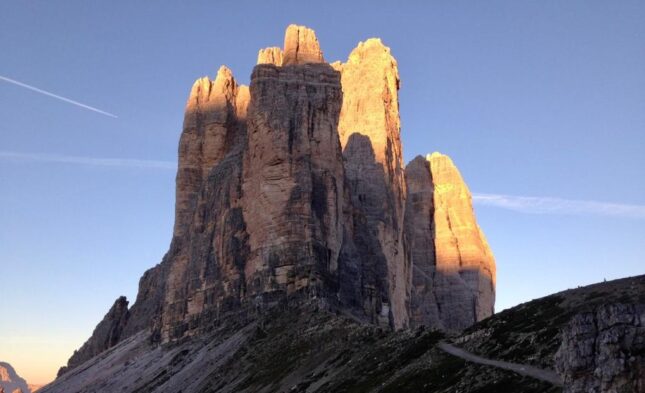
Working together some years later, we were both accepted on the British Mountain Guide scheme and qualified as IFMGA Mountain Guides at the same time.
Don’t miss the other articles in this series:
Six North Faces: Aiguille du Dru
Six North Faces: Grandes Jorasses
About Stuart McAleese IFMGA
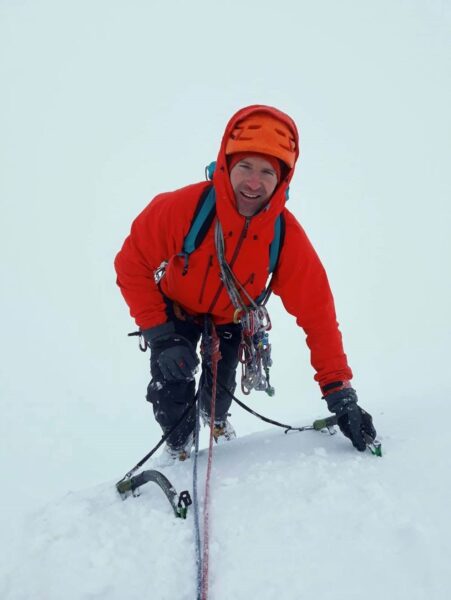
Originally from Northern Cumbria I started out hill walking in the Lake District when I was at school. I soon become interested in rock climbing and mountaineering, and was lucky enough to work and climb with Mountain Guides during my first job leaving school. Since then I’ve been working full time in the mountains for around 20 years.
At the same time as working, I enjoy climbing in my free time and have been lucky enough to go on many expeditions around the world, climbing new mountains, first ascents and tough remote summits. Places such as Patagonia, Alaska, Himalaya, Peru, Baffin Island, Yosemite and China. In 2004 I was nominated for the prestigious Piolet d’Or in Grenoble, France, for a 1st ascent of the ‘Supa Dupa Couloir’ in Alaska.
I love my job as a Mountain Guide, teaching and exploring big mountains in all weather all year round. I joined the Glenmore Lodge team in 2019 and head up the Summer Alpine programme as well as delivering on the Rock & Mountain programme of training courses.